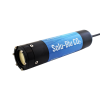Pro-Oceanus Mini Dissolved CO2 Probe
Features
- Compact size with low power consumption
- Large selection of concentration ranges
- Internal data logger with 2GB flash memory
- Expedited repair and warranty service
- Lifetime technical support
- More
Overview
The Pro-Oceanus Mini CO2 instrument uses infrared detection to measure the partial pressure of CO2 gas dissolved in liquids. With pCO2 ranges from 0-1000 ppm up to 0-100%, the Mini CO2 provides the versatility needed for any application.
Mechanics
The Pro-Oceanus Mini CO2 submersible instruments are compact, lightweight, plug-and-play sensors. The instrument also measures total dissolved gas pressure (TDGP), a useful parameter for many applications and data correction.
Applications
With resistance to most corrosive liquids, the Mini CO2 can provide reliable dissolved carbon dioxide data for many applications. Flow-through and in-line adapters are also available for simple and effective industrial solutions.
| Sensor Performance | |
|---|---|
| CO2 Measurement Ranges | 0-2000 ppm CO2; by volume 0-5000 ppm 0-1% (10,000 ppm) 0-100% *other ranges available |
| Total Dissolved Gas Pressure | 0-2000 mbar |
| Accuracy: pCO2 | ± 2% of max range |
| TDGP | ± 1% |
| Equilibration rate (t63) | 3 minutes |
| Resolution | 0.1% of max range |
| Physical | |
|---|---|
| Length | 28 cm (11 in) |
| Diameter | 5.3 cm (2.1 in) |
| Weight | Air 0.53 kg (1.2 lbs) Water: -0.06 kg (-0.1 lbs) |
| Housing Material | Acetal Plastic |
| Depth Rating | 0 - 600m |
| Water Temperature | 0º to 40º C |
| Electrical | |
|---|---|
| Input voltage | 7-24 VDC |
| Power consumption | 85 mW (7 mA @ 12 V) |
| Data output | RS-232, ASCII format |
| Sample rate | 2 seconds (variable rate with logger/controller) |
All models include:
- Mini CO2 Instrument
- USB memory stick with Oceanus Software and User’s Manual
- QuickStart Guide
Power and communications deck box includes:
- Water-Resistant deck box with Underwater Cable and Connector Sleeve
- 2-meter RS-232 cable
- RS-232-to-USB Converter
- AC to DC 12 V Power Supply
Internal rechargeable battery models include the items above as well as a battery pack and charger.
In The News
Great Lakes Research Center: Designing Targeted Monitoring Solutions
According to the National Oceanic and Atmospheric Administration ( NOAA ), the Great Lakes have more miles of coastline than the contiguous Atlantic and Pacific coasts combined and contain 20 percent of the world's freshwater, making it a critical region to protect and conserve. Continuous monitoring and data-informed resource management are key components of managing waters in the region. Hayden Henderson, a research engineer with the Great Lakes Research Center (GLRC), designs and deploys monitoring platforms throughout the Great Lakes. With a background in environmental engineering, Henderson enjoyed the challenge of creating systems and making them work to obtain difficult, remote measurements.
Read MoreWildfire Prevention in the Sierra Nevada Region with the Yuba Watershed Institute
Though recent wildfires have sparked new conversations about wildfire management and response, groups like the Yuba Watershed Institute have been monitoring the forests and water resources of the Sierra Nevada region for decades, managing approximately 5,000 acres of land with the Bureau of Land Management (BLM) and about 7,000 acres in private land partnerships. The goal of the Institute is to work with local communities and land agencies to improve watershed and forestry management through informed practices and public outreach. The goals of the Yuba Watershed Institute are three-fold: Improve the ability of fire suppression agencies like the California Department of Forestry and Fire Protection ( CAL FIRE ) and the US Forest Service.
Read MoreWave Sensors Integration with NexSens Buoys: A Cutting-Edge Solution for Wave Measurment
Real-time wave data supports accurate weather prediction, safe and efficient maritime operations, and provides valuable safety and operating condition information for recreation and commercial fishing. Understanding wave dynamics also helps with the design of protective coastal structures like seawalls, breakwaters, and jetties. It also supports better prediction of their impact on sediment transport and coastal geomorphology. Wave data is a key factor in qualifying and designing offshore wind farms and harnessing kinetic energy for electrical generation. It helps with the understanding of ocean-atmosphere interactions and contributes to studies of sea-level rise and climate change impacts.
Read More





























